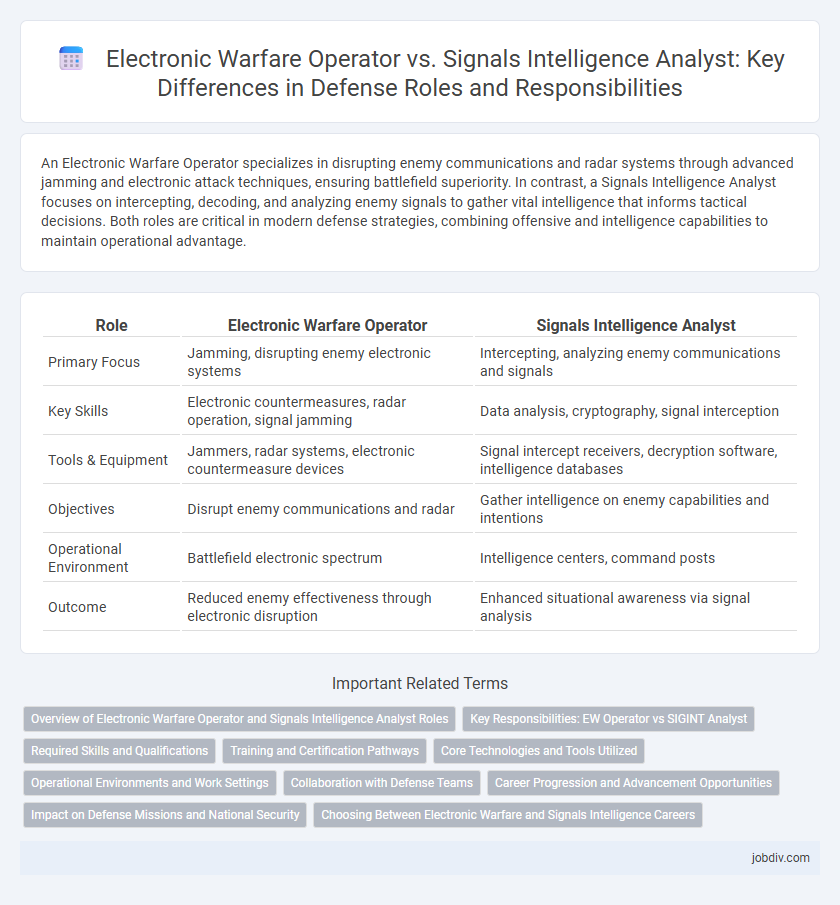An Electronic Warfare Operator specializes in disrupting enemy communications and radar systems through advanced jamming and electronic attack techniques, ensuring battlefield superiority. In contrast, a Signals Intelligence Analyst focuses on intercepting, decoding, and analyzing enemy signals to gather vital intelligence that informs tactical decisions. Both roles are critical in modern defense strategies, combining offensive and intelligence capabilities to maintain operational advantage.
Table of Comparison
| Role | Electronic Warfare Operator | Signals Intelligence Analyst |
|---|---|---|
| Primary Focus | Jamming, disrupting enemy electronic systems | Intercepting, analyzing enemy communications and signals |
| Key Skills | Electronic countermeasures, radar operation, signal jamming | Data analysis, cryptography, signal interception |
| Tools & Equipment | Jammers, radar systems, electronic countermeasure devices | Signal intercept receivers, decryption software, intelligence databases |
| Objectives | Disrupt enemy communications and radar | Gather intelligence on enemy capabilities and intentions |
| Operational Environment | Battlefield electronic spectrum | Intelligence centers, command posts |
| Outcome | Reduced enemy effectiveness through electronic disruption | Enhanced situational awareness via signal analysis |
Overview of Electronic Warfare Operator and Signals Intelligence Analyst Roles
Electronic Warfare Operators specialize in disrupting or deceiving enemy electronic systems through methods such as jamming, electronic attack, and electronic protection. Signals Intelligence Analysts collect, analyze, and interpret intercepted communications and electronic signals to provide actionable intelligence for military operations. Both roles are critical in modern defense strategies, enhancing situational awareness and operational effectiveness through electronic spectrum dominance and intelligence exploitation.
Key Responsibilities: EW Operator vs SIGINT Analyst
Electronic Warfare Operators specialize in disrupting, deceiving, or denying enemy electronic systems through jamming, electronic attacks, and countermeasures, ensuring dominance over the electromagnetic spectrum. Signals Intelligence Analysts focus on intercepting, analyzing, and interpreting enemy communications and electronic signals to provide critical intelligence for strategic decision-making. Both roles are pivotal in modern military operations, with EW Operators concentrated on active electronic engagement, while SIGINT Analysts provide passive signal collection and intelligence assessment.
Required Skills and Qualifications
Electronic Warfare Operators require expertise in radar systems, electronic attack techniques, and real-time signal disruption to counter enemy threats effectively. Signals Intelligence Analysts need advanced skills in signal interception, cryptanalysis, and data interpretation to extract actionable intelligence from complex communications. Both roles demand proficiency in cybersecurity protocols, analytical thinking, and knowledge of electromagnetic spectrum management.
Training and Certification Pathways
Electronic Warfare Operators undergo rigorous training focused on radar, jamming techniques, and electromagnetic spectrum management, typically provided by military-specific programs such as the U.S. Air Force's Electronic Warfare Officer Course. Signals Intelligence Analysts receive specialized instruction in signal interception, cryptanalysis, and data exploitation, often through agencies like the National Security Agency (NSA) and Defense Intelligence Agency (DIA), with certifications such as the Certified Information Systems Security Professional (CISSP) enhancing career advancement. Both roles require continuous education to stay current with evolving technologies, with Electronic Warfare Operators emphasizing hardware operation while Signals Intelligence Analysts focus on intelligence gathering and analysis methodologies.
Core Technologies and Tools Utilized
Electronic Warfare Operators utilize advanced jamming systems, radar disruption technologies, and signal interception devices to manipulate and control the electromagnetic spectrum. Signals Intelligence Analysts rely heavily on sophisticated cryptographic software, signal decryption tools, and data analysis platforms to intercept, decode, and interpret enemy communications and electronic signals. Both roles integrate cutting-edge technologies like software-defined radios, spectrum analyzers, and next-generation AI-driven signal processing to enhance operational effectiveness in modern defense environments.
Operational Environments and Work Settings
Electronic Warfare Operators primarily operate in dynamic combat environments where real-time jamming, deception, and electronic attack tactics disrupt enemy communications and radar systems, often deployed on military platforms such as aircraft, ships, and ground vehicles. Signals Intelligence Analysts function in more controlled, secure settings like intelligence centers where they intercept, analyze, and interpret a wide range of electromagnetic signals to support strategic and tactical decision-making. Both roles require expertise in electromagnetic spectrum operations but differ significantly in their immediate operational contexts and the tempo of their work environments.
Collaboration with Defense Teams
Electronic Warfare Operators and Signals Intelligence Analysts collaborate closely with defense teams to enhance situational awareness and decision-making capabilities on the battlefield. Electronic Warfare Operators focus on disrupting enemy communications and radar systems, while Signals Intelligence Analysts interpret intercepted signals to provide actionable intelligence. Their integrated efforts enable real-time threat detection and strengthen overall mission effectiveness.
Career Progression and Advancement Opportunities
Electronic Warfare Operators advance through hands-on technical roles involving radar, jamming, and electronic countermeasures, often progressing to leadership positions in tactical operations and electronic warfare systems management. Signals Intelligence Analysts typically follow a path emphasizing data interpretation, cryptanalysis, and cybersecurity expertise, leading to strategic intelligence roles and positions in threat assessment and cyber defense. Career advancement for both roles benefits from continuous technical training, security clearances, and opportunities to specialize in emerging technologies such as artificial intelligence and cyber warfare.
Impact on Defense Missions and National Security
Electronic Warfare Operators directly disrupt enemy communications and radar systems, enhancing battlefield advantage and protecting military assets from detection and attack. Signals Intelligence Analysts gather, decode, and interpret intercepted transmissions, providing critical intelligence that informs strategic decisions and threat assessments. Together, these roles synergize to strengthen situational awareness, reduce operational risks, and safeguard national security against evolving electronic threats.
Choosing Between Electronic Warfare and Signals Intelligence Careers
Electronic Warfare Operators specialize in disrupting enemy communications and radar systems through jamming and deception techniques, playing a critical role in battlefield dominance. Signals Intelligence Analysts focus on intercepting and deciphering electronic signals to gather actionable intelligence, supporting strategic decision-making. Choosing between these careers depends on preference for direct operational engagement versus analytical intelligence processing within defense missions.
Electronic Warfare Operator vs Signals Intelligence Analyst Infographic

 jobdiv.com
jobdiv.com